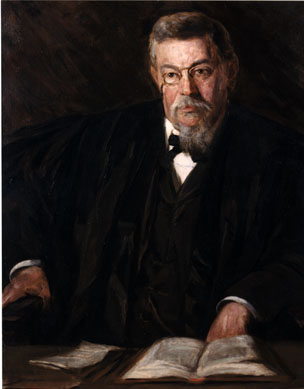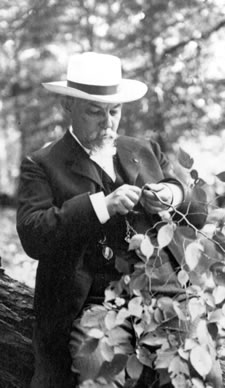Governor Samuel Whitaker Pennypacker
Term
January 20, 1903 - January 15, 1907
Affiliation
Republican
Born
April 9, 1843
Died
September 2, 1916

Photo courtesy of Capitol Preservation
Committee and John Rudy Photography
Biography
Samuel Whitaker Pennypacker was described as "the perfect Victorian," and "the ideal first governor of the twentieth century." Pennypacker was born in Phoenixville, Chester County, on April 9, 1843. He descended from Hendrick Pannebakker (Dutch for "maker of tiles"), an émigré from Crefeld, Germany, of Dutch origin, who was a surveyor for William Penn. His grandfather, Mathias Pennypacker, a member of the General Assembly and president of the Philadelphia and Reading Railroad, helped write the Pennsylvania Constitution of 1837. His mother, Anna Maria Whitaker, came from a family that owned a local ironworks. His father, Isaac Pennypacker, was the first burgess (similar to mayor) of Phoenixville and held a professorship at the Philadelphia Medical College. Young Pennypacker, after attending Northwest Grammar School, Philadelphia, was given a scholarship at Saunders Institute, West Philadelphia, but before completing his studies, his father died of typhoid fever. The young scholar returned to live with his mother and maternal grandfather, Joseph Whitaker, and completed his education at nearby Grovemont Seminary.
He prepared for Yale University, but his grandfather refused to provide tuition money, believing instead that Pennypacker should first prove himself in the work force. In the fall of 1862 and that winter, he taught in a one-room schoolhouse in nearby Mont Clare, Montgomery County. Pennypacker, at five-foot, ten inches tall, weighing a lean 127 pounds, was frustrated by his inability to "establish and enforce discipline" among a disorderly group of students.
When Confederate General Robert E. Lee invaded Pennsylvania in 1863, Pennypacker enlisted in Company F of Pottstown, 26th Pennsylvania Emergency Regiment. Despite being mustered for only six weeks and receiving just two days of training, they were among the first forces to engage the rebels at Gettysburg. Although 176 men from the 26th Regiment were captured and a few wounded, Pennypacker avoided catastrophe at the hands of seasoned Georgia soldiers when Union regulars relieved the 26th. Convinced that his grandson had proven himself, Whitaker arranged for Pennypacker to study law at the University of Pennsylvania and an apprenticeship in the office of Peter McCall. In 1865, he was elected president of the Bancroft Literary Union. In 1866, he earned his bachelor of laws degree and established his own law practice, and in 1867, he was chosen president of the Law Academy of Philadelphia.
On October 20, 1870, he married his childhood sweetheart, Virginia Earle Broomall, daughter of Nathan B. Broomall. The Pennypackers had three daughters and one son. By the end of the decade he received a doctor of laws from Franklin and Marshall College.
Pennypacker's foray into public service began in 1885 when he was appointed to the Philadelphia Board of Education. He was admitted to the bar of the Supreme Court of the United States in 1887 and in 1889 Governor James A. Beaver appointed him judge of the Court of Common Pleas of Philadelphia. He became president judge in 1897 and was reelected in 1899. He became president of the Historical Society of Pennsylvania in 1900, during which time Pennypacker did his most prolific writing on topics such as early local and state history, English common law, the Supreme Court, genealogy, and several biographies. He also amassed more than ten thousand volumes in his personal library and self-mastered Dutch, German, and Spanish. He learned French at Saunders Institute and Latin at Grovemont Seminary. His polished intellect, public experience, and the fact that his distant cousin was U.S. Senator Matthew Quay, made him one of the most powerful Republicans in Pennsylvania.
In 1902, Pennypacker defeated John P. Elkin, the Republican state attorney general, for the gubernatorial nomination. The Quay and Boies Penrose political machine were accused of buying votes from Elkin supporters, which they denied. In the general election, Robert Pattison, the only Democrat to serve as governor between the Civil War and 1935, sought a third non-successive term after serving 1883-1887 and 1891-1895. However, the momentum was on Pennypacker's side. He picked up the endorsements of veterans, agricultural interests, popular former governor and Civil War hero James Beaver, and President Theodore Roosevelt, who publicly proclaimed that Pennypacker's defeat would be a "national calamity." Pennypacker easily defeated Pattison by more than 142,000 votes.
Pennypacker downplayed the Quay influence and demonstrated that he was no pawn of Philadelphia 's Republicans. While he promised in his inaugural address on January 20, 1903, to limit the amount of legislation passed, his record shows significant legislation that made major changes in Pennsylvania society and state government. The industrial revolution created new problems for society. Child labor, strikes and violent riots, workers' rights, government corruption, over-exploitation of natural resources, food safety, and the need for better roadways for commerce kept the governor busy.
The Child Labor Act of 1905, while it did not completely abolish child labor, set the minimum age for factory and mine work at fourteen and prohibited most night work. That year, more than 6,300 underage children were dismissed out of 120,000 youths in the labor force. Among adult laborers, violent labor confrontations plagued mills and mines and overwhelmed local authorities. Company owners hired what was referred to as the Coal and Iron Police to protect company interests. Although the state authorized these private police, many of those hired were nothing more than street thugs who used violence and blackmail to force laborers into compliance with company policies. Governor Pennypacker, who regarded the Coal and Iron Police as unconstitutional, was determined to restore law and order by more legitimate means. He directed John C. Groome to create the Pennsylvania State Police, the first statewide police force in America, modeled after the Royal Irish Constabulary (the Texas Rangers were created prior, but initially as a militia). The State Police, however, quickly earned a reputation of efficiency, integrity, honor, and respect, including public acclamations by President Roosevelt.
 An ardent conservationist, Pennypacker appointed the first commissioner of forestry, Joseph Trimble Rothrock. Half a million acres of land were preserved, twelve thousand acres for game, tree nurseries were established, and the first school for state foresters was opened at Mont Alto, Franklin County. In 1905, Pennypacker signed legislation authorizing the establishment of a State Museum to house the accumulated artistic, historical, and natural treasures of the state. In addition, new taxes were levied on out-of-state corporations who mined and exported Pennsylvania coal. The tax revenue financed eight thousand miles of paved roads in the state and was viewed as a national model. Pennypacker also advocated the enforcement of the 1895 Pure Food Law that prohibited the adulteration of food products to conceal inferiority.
An ardent conservationist, Pennypacker appointed the first commissioner of forestry, Joseph Trimble Rothrock. Half a million acres of land were preserved, twelve thousand acres for game, tree nurseries were established, and the first school for state foresters was opened at Mont Alto, Franklin County. In 1905, Pennypacker signed legislation authorizing the establishment of a State Museum to house the accumulated artistic, historical, and natural treasures of the state. In addition, new taxes were levied on out-of-state corporations who mined and exported Pennsylvania coal. The tax revenue financed eight thousand miles of paved roads in the state and was viewed as a national model. Pennypacker also advocated the enforcement of the 1895 Pure Food Law that prohibited the adulteration of food products to conceal inferiority.
The governor also garnered the most intense acrimony from the Philadelphia press of any governor in Pennsylvania 's history. The Progressive Era gave birth to many journalists who sought to expose corruption, for whom President Roosevelt coined the term "muckrakers." Pennypacker immediately drew vicious attacks in the press with the passage of the Salus-Grady Bill, or the Newspaper Libel Act of 1903 (repealed in 1907). Pennypacker believed that liberty of the press was an anachronism and that, in general, the urban press often sacrificed responsible journalism to libelous statements, sensational headlines, vulgarities, and detailing horrible crimes for the purpose of selling newspapers. His motive was to make the press more accountable for libel, but newspaper owners saw it as as a violation of the First Amendment of the U.S. Constitution and curtailing liberty.
After the state capitol building burned down in 1897, the General Assembly, during the administration of Governor Stone, appropriated four million dollars in funds to rebuild, not including furnishings. On October 4, 1906, the new building, rivaling the nation's capitol building, with a dome resembling St. Peter's Basilica in the Vatican, was dedicated and described by Pennypacker as "the most elaborate and complicated constructive work ever undertaken by the state." Pennypacker believed that a grand and opulent public building would exalt Pennsylvania 's status as the Keystone State.
The building was completed on time and within the budget. However, Democratic State Treasurer William Berry discovered that, although $900,000 additional was appropriated for furnishings, flooring and ceilings, oak wainscoting, and artwork, the actual additional unappropriated cost was $7.7 million. There were overcharges for purchases using questionable methods of computing costs, such as charging by the pound for chandeliers, or charging for the "air space under furniture." After an investigation, convictions on charges of conspiracy and false pretense were obtained against architect Joseph Huston, lead contractor John Sanderson, former Auditor General William P. Snyder, and former State Treasurer William L. Mathues. Governor Pennypacker was not indicted nor did the public perceive the governor as being dishonest. Pennypacker also pointed out that the Commonwealth did not raise taxes or go into debt and that other great buildings less grand than the capitol took longer to build and were much more costly. The capitol today remains an important architectural landmark of Pennsylvania, drawing admiring visitors from around the world.
Following his term in office, Pennypacker opened a law office in Philadelphia and wrote extensively, including his autobiography and his commentary on the Capitol Building scandal. Samuel Pennypacker died on September 2, 1916, at his home in Schwenksville and is buried in Morris Cemetery, Phoenixville, Chester County.
Pages in this Section
- 1876-1951
- John Frederick Hartranft
- Henry Martyn Hoyt
- Robert Emory Pattison
- James Addams Beaver
- Daniel Hartman Hastings
- William Alexis Stone
- Samuel Whitaker Pennypacker
- Edwin Sydney Stuart
- John Kinley Tener
- Martin Grove Brumbaugh
- William Cameron Sproul
- Gifford Pinchot
- John Stuchell Fisher
- George Howard Earle
- Arthur Horace James
- Edward Martin
- John Cromwell Bell Jr.
- James Henderson Duff